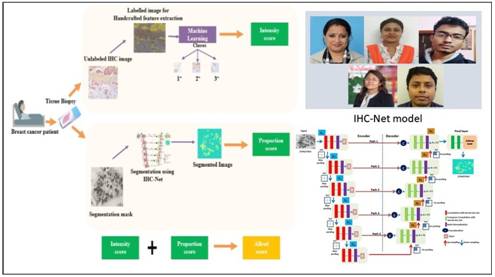Scientists have developed a classification method based on Deep Learning (DL) network to evaluate hormone status for prognosis of breast cancer. The proposed framework is a reliable alternative to manual methods for automatic grading systems used to determine scoring of estrogen receptor status for predicting progression of breast cancer.
Breast cancer is the most common invasive cancer, which accounts for 14% of cancers amongst Indian women, both in rural and urban India. In India, post-cancer survival rate related to breast cancer was reported to be 60% which is approximately 80% of Indian patients younger than 60 years of age. Such alarming numbers could be reduced if the cancer is diagnosed at an early stage.
A team from the Institute of Advanced Study in Science and Technology (IASST), an autonomous institute of the Department of Science & Technology, Govt. of India, have presented the novel Deep Learning (DL) based quantitative evaluation of estrogen or progesterone status with the help of Immunohistochemistry (IHC) specimen to grade for prediction of breast cancer.
The study by Dr. Lipi B Mahanta and her group was done in collaboration with clinicians of B Borooah Cancer Institute, the premier cancer institute of the region. With an enormous prospect for converting to a workable commercial software, this work has been accepted for publication in the pioneer journal “Applied Soft Computing”.
While breast cancer is generally diagnosed after a visual microscopic examination of a biopsy sample, for prognostic and predictive stratification, IHC molecular marker plays a vital role. IHC strain is used as a prognostic marker in breast cancer pathology and involves a special kind of colour staining for identifying malignant nuclei. It possesses different intensity based on which categories are defined in terms of Allred score (ranges 0 to 3) respectively. Scoring systems called Allred and H-score are used by pathologists in the quantification of the immunohistochemical reaction of estrogen receptor (ER) and progesterone receptor (PR) tissue slides. Hormone receptors, namely estrogen receptor (ER) and progesterone receptor (PR) contribute to predicting cancer progression and associated risk of late recurrence of the disease.
This prompted to find effective solutions towards its management with the assistance of advanced artificial intelligence technologies. The team developed an algorithm that indicated whether or not the cancer cells have hormone receptors on their surface. This study proposed a new method based on deep learning network for precisely segmenting out the stained nuclei region from breast tissue images. The proposed architecture, namely IHC-Net, can semantically segment the exact positive and negative nuclei from tissue images. Finally, an ensemble method is used, which integrates the decision of three machine learning (ML) models for the final Allred cancer score.

[Publication link: https://doi.org/10.1016/j.asoc.2021.107136










